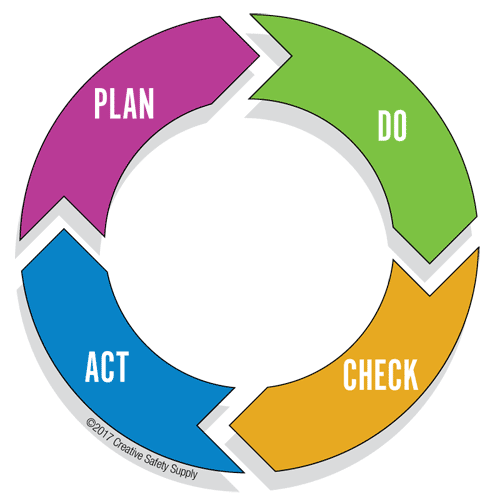
A quality circle is a group of people in the workplace who perform the same, or similar, functions in their job. They meet regularly to look at different ways to discover and solve issues related to their role at work. Also known as a quality control cycle, these groups of people will normally be small in number (3-10) and be led by the supervisor.
Simple adjustments to how work is performed can be adopted just with agreement among the group, but larger solutions to problems will typically need to propose the solution to management teams. Each company will have a different set of policies on how changes will be implemented based on their own specific needs.
History of Quality Circles
Quality circles got their start in the 1950's with the concept being pioneered by W. Edwards Deming. Toyota liked the idea and began using it in a variety of ways throughout their manufacturing facilities and other areas. Companies around the world began implementing this strategy, and by 1978 there were more than a million circles operating with ten million workers involved in Japan alone.
The concept of quality circles has somewhat fallen out of favor in many western countries over the past couple decades, it was a very popular option throughout the 1960's, 70's, and 80's. Some companies are beginning to realize how quality circles can be effective again, especially when combined with other methodologies like Lean, Six Sigma, and more.
Quality Control Circle
Quality circles have been shown to be an effective way to encourage continuous improvement in almost any type of work environment. There have even been empirical studies performed that show that when implemented correctly, quality control circles allow more work to get done, with fewer people, than jobsites that don't use this concept.
Quality Circle Process

Most quality circles will work through a set process with each meeting. In general, this will follow the Plan, Do, Check, Act process, which is ideal for continuous improvement projects.
Following this process not only makes it easier to identify potential solutions and implement them, but it also has an established flow for moving from one process improvement to the next. This is important because this type of group meeting is scheduled to take place on a regular basis, with new problems being identified and resolved on a regular basis.
Q.C. Examples
Many companies today use quality circles, especially when it comes to manufacturing. The most well-known example would be Toyota, which helped to pioneer the concept decades ago. These circles continue to meet on a regular basis to identify potential problems and get them resolved as efficiently as possible.
Another example would be Lockheed Martin. Lockheed Martin began using quality circles in their manufacturing facilities back in 1974. Executives from this company learned of quality circles when visiting Japanese manufacturing plants, and saw how beneficial they could be. Soon after Lockheed Martin, a number of other US companies added them to their workplaces, including GM, Northrop, and Westinghouse.
These are good examples of large corporations using quality circles on a broad scope. Looking some of the ways a quality circle can work in an average manufacturing facility can be just as effective. The following are some examples of how a typical quality can provide benefits to the workplace.
- Discussing Best Practices - In many workplaces, there are multiple shifts of people who do the same or similar work. By getting everyone together in one place, it is possible to identify which shift is working most efficiently, and use that to create best practices that can be followed across all shifts.
- Pointing Out Issues - Employees often know of lots of minor (or even major) issues, but they assume that someone else is working on getting them fixed. When a quality circle meets, they can discuss these types of issues, and take ownership of them to actually move forward with a positive result.
- Collaborating on Solutions - One of the biggest examples of how a quality circle can help is that it is the actual employees who are working to come up with solutions to problems. Those who have to deal with the problems are typically the best people to fix it. Since they are also working on the issue themselves, there will be far less pushback on a proposed solution.
- Brainstorming Ideas - When a circle meets, everyone will be familiar with the position so they can more easily bounce ideas off of each other. Brainstorming ideas is a very effective way to arrive at the best possible solution to a problem.
- Streamlined Problem Solving - If management or another outside group tries to come up with solutions to a known problem, it will take a lot longer to learn about how things are done, and how a problem can be fixed. Those with experience in the department won't need to waste time learning about the problem before proposing solutions.
Quality Circle Tools
A quality circle can use any type of tools that they would like to help improve their roles. Some of these circles are more casual and just talk about different issues with their jobs, and propose solutions. In this type of situation, a simple notepad could be sufficient. While this can be a good place to start a quality control circle, it is best if they evolve into something more formal where more detailed problems can be addressed.
When this happens, some of the following quality improvement tools are often incorporated to help discover the root causes to issues, and how to fix them.
- Flowcharts
- Scatter Plots
- Run Charts
- Graphical Tools
- Process Mapping Tools
- Pareto Charts
- Fishbone Diagrams
There are many other potential tools that a group could use depending on the specific problems they are trying to overcome. When equipped with the right tools, a quality circle is able to more efficiently identify issues, and propose solutions, which is the main goal of these groups.
Quality Management System
Quality circles are considered a quality management system, which is a collection of different business processes that are designed to help improve the ability of a company to meet customer requirements. The quality circles should always keep this in mind when meeting or coming up with new ideas.
Any problem that is discovered by the quality circles needs to be solved in a way that meets the guidelines of a quality management system. Specifically, this means that it needs to be in line with something that customers are actually demanding. Companies that don't keep this in mind often end up creating a lot of waste by having features or options that customers may use, but they would not be willing to pay more for.

Measuring Success of Quality Circles
It is important that quality circles gather data and measure their success in order to ensure things are actually having a positive impact on the workplace. When groups of people from one department get together and propose solutions to problems, it can be tempting to try to come up with an agreement on how something should be done, and then implement it immediately.
This can open up the possibility of having many problems, but even when it does become a good solution, it is hard to know why it was effective unless they also gathered data. Before a solution is put in place, the group should gather data on how things are currently operating, so it can be used as a baseline to measure against.
By having all the information available before changes are made, the quality circle will be able to show exactly how much improvement they have generated. This data will be able to be used for future justifications of process improvement plans, and to help ensure the company continues to support the concept of quality circles operating within the facility. It may seem like it takes more time to gather this data at first, but it will be well-worth the effort.
Implementing Quality Circles
When implementing quality circles, it is important to provide some guidance to the groups to get started. Companies that simply ask different departments to get together once a month to discuss how things can be improved will often find that the meetings are unproductive, and end up turning into a waste of time.
A company will often have one person who has become an expert in quality circles and how they work attend meetings with each circle for the first several times. This can provide some direction on how things should be done, and they can answer any questions that the attendees have. It is important to ensure that the expert doesn't try to take over the circle, or have the circle become overly reliant on them though, since this should just be a temporary thing to get things up and running.
Quality circles should be measured based on their success in improving the productivity of their department, eliminating waste, and otherwise benefiting the company. If the quality circles become unproductive, the expert in this area can be brought back in to provide additional direction to the group.
Resources
- https://en.wikipedia.org/wiki/Quality_management_system
- https://www.referenceforbusiness.com/small/Op-Qu/Quality-Circles.html
Similar Articles
- Quality Control in Manufacturing
- Quality Management Systems (ISO 9001:2015)
- Quality Control
- William Edwards Deming: The Father of Quality Management
- Quality, Health, Safety, Environment (QHSE) Management Systems
- The Five Whys (Root Cause Analysis)
- 5 Lean Principles for Process Improvement
- Continuous Improvement (A Kaizen Model)
- 8D for Problem Solving


